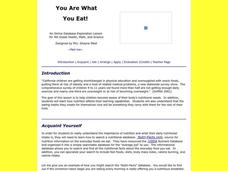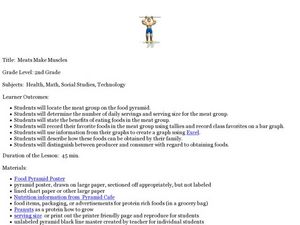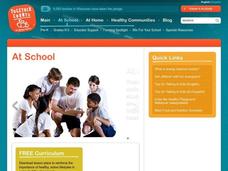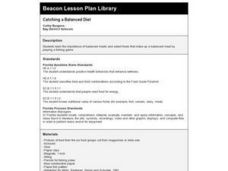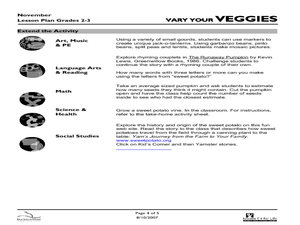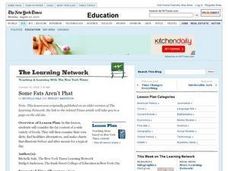Curated OER
Dietician - Nutritionist
There are so many different career opportunities in the health care field. Have learners explore what it takes to be a dietician or a nutritionist. They'll view a PowerPoint on each occupation and take mini-quizzes while they watch. A...
Nemours KidsHealth
Obesity: Grades 6-8
Screen time and fast foods, sugary drinks and greasy fries have lead to one-third of tween and teens being overweight or obese. As part of the Health Problems Series scholars analyze the nutritional value of the school food services menu...
Baylor College
Using Food Labels
Help your class make sense of nutrition labels with the ninth activity of this series. After explaining the different information provided on packaged food labels, perform an activity that demonstrates the amount of sugar in a single can...
Curated OER
Steps to a Healthier You
Students explore the food pyramid. In this dietary health lesson, students examine the food pyramid on the MyPyramid.gov website and discuss healthy eating strategies. There are various links to websites in this lesson.
Curated OER
Coffee & Chocolate: Knowing Healthy Foods
An article relaying vital information about health and nutrition are the backbone of this lesson on eating the right foods. A series of activities are used to help upper graders understand the science supporting our understanding of what...
Curated OER
Dietary Rules
Healthy eating habits is the focus of this resource. Learners discuss fat and cholesterol, caloric needs, and the importance of exercise. There is a worksheet and a handout of dietary guidelines to supplement the information provided.
Curated OER
Organic Mechanic Part I
On day one of the "Organic Mechanic Part I" lesson, learners try to remove the waxy coating of an apple and consider pesticides that may be represented by this addition to our food. On day two, they research pesticides online and...
Curated OER
You Are What You Eat!
Fourth graders discover the nutritional needs of their bodies. Using a database, they research how nutrition affects their learning capabilities. They take the food they eat on a daily basis and discover its nutritional value. They...
Curated OER
Starches, Fats And Sweets, Oh No!
Students log their food intake for one week and analyze their diet using the food pyramid. They then design a week of nutritional meals and snacks for a young child that they might baby-sit.
Curated OER
Calcium Counts
Students evaluate the food pyramid. In this dairy nutrition lesson, students identify the position of the milk group on the food pyramid, then determine their daily calcium requirement and how they can meet that requirement.
Curated OER
Your Energy Balance Goal!
This is the last lesson in the series put out by Together Counts on health. This activity has youngsters setting goals to keep their energy balanced by making excellent eating and activity choices. They may need a little help making...
Curated OER
Meats Make Muscles
Second graders explore the meat group of the food pyramid. In this nutrition and diet lesson, 2nd graders study the benefits of eating foods in the meat group, collect data regarding their classmates' favorite foods, and create a graph...
Curated OER
Energy Plus!
This lesson seems pretty advanced for K-2nd graders, but there are some pieces that can be used with young learners. Look through this comprehensive, fact-filled lesson and pull out information and activities that you can adapt to fit...
Beacon Learning Center
Catching a Balanced Diet
First graders explore the importance of balanced meals. They play a fishing game to help them select foods to make up a balanced meal.
Curated OER
The Color Way
Students study the importance of eating a colorful diet of fruits and vegetables. In this nutritional diet lesson, students complete multiple activities to learn about the nutritional value of colorful fruits and vegetables.
Curated OER
Nutrition: One Hot Topic!
Students learn the content of the food groups and are better prepared to maintain a healthy diet and lifestyle. Students identify the main food groups and list content examples. Students create a cookbook of new and healthy snacks.
Curated OER
Hunger and Malnutrition
Sixth graders use a variety of resources to determine the importance of getting the proper nutrients. In this nutrition lesson, student complete an activity in which they examine the world issue of hunger and malnutrition. They locate...
Curated OER
Fit For Life Presentations
Students use the internet to compare and contrast the diet, nutrition and fitness of a major language group and the United States. As a class, they are introduced to the vocabulary in the language related to health and fitness and share...
Curated OER
Exploding Cheeseburger
Second graders describe the components of a healthy diet. For this nutrition and health lesson, 2nd graders identify the importance in eating a variety of healthy food. Students explain what makes a healthy diet.
Curated OER
A Balanced Diet
High schoolers determine which healthy foods comprise a well balanced meal. Using a checklist, students classify foods as healthy or unhealthy. This lesson is intended for high schoolers acquiring English.
Curated OER
Smart Snacking
Students define what a snack is in their own words. For this adult health lesson, students discuss the benefits of eating healthy snacks. They give examples of new healthy foods then can serve for snacks.
Curated OER
Rice Nutrition
Third graders investigate nutrition by researching rice. In this food lesson, 3rd graders read about the healthy aspects of rice and how many people in the world eat it. Students read nutrition labels and discuss the...
Curated OER
Menu Madness
Students determine the nutritional values of fast foods. Then they make comparisons of their results and present their findings to the class. They compare the nutritional values of fast foods based on information provided on menus.
Curated OER
Some Fats Aren't Phat
Students examine nutritional information on various food labels and then consider the nutritional value of the foods in their own diets. They create posters illustrating their diets "before" and "after" they considered their fat intake.









